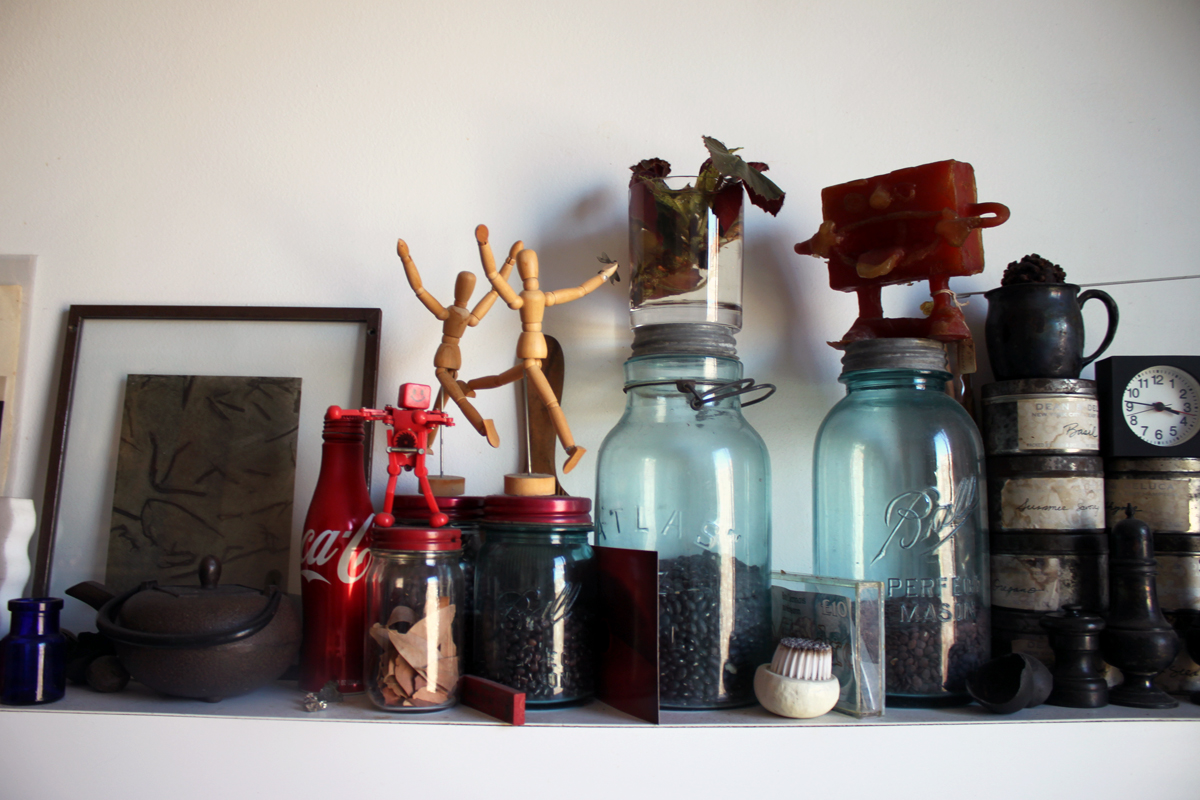Studio Visit: Conceptual Artist Dove Bradshaw
A look behind some of her stone work currently on show at the Noguchi Museum


by Natasha Tauber
In the live/work space artist Dove Bradshaw shares with her partner of 41 years, artist William Anastasi, every sightline is assembled in deference to her eye and the couple’s evolving artistic harmonies. Dense pockets of books and recordings are points of gravity, in an expansive light-filled upper Manhattan apartment made loft-like by the removal of many of its 1913 walls. In art, as in life, Bradshaw brings a minimalist’s eye to the conceptual work she creates—without material or aesthetic sacrifice.

The tableaux Bradshaw assembles throughout the space are curated from the works of friends—colleagues central to one of the past century’s most acclaimed artistic movements. A maquette for Claes Oldenburg’s Mouse Museum perches on a Sol LeWitt vertical shelf/sculpture, adjacent to a work Robert Ryman signed and dated to the column. Winking homages best labeled “after Duchamp” abound. A bottle-rack hung from the ceiling—strung with lights that absorb daylight and illuminate indeterminately—is a ready-made chandelier. “What artists take from Duchamp is permission,” suggests Bradshaw. Her score for “Angles” (a series in which the roll of a die specifies the horizon of a triangular painting each day of its exhibition) sits at the upright piano.

In a loft full of instruments—musical and scientific—the hum of intimate collaborations defies stagnant representation. John Cage’s musical scores and Merce Cunningham’s choreography are framed on walls, homages to a creative fugue for which Bradshaw provided the visual accompaniment. At the kitchen table, she produces a linen box in which 10 years of sets and costumes she designed as an Artistic Advisor to Cunningham’s dance company are archived. In turn, it was the avant-garde Cage, Cunningham’s life and work partner, who would function as a mentor to Bradshaw.

As someone who is considered a pioneer of “indeterminacy,” Bradshaw has a segment of oeuvre that casts decision and chance at the moment of impact. She “stops time” with a just-cracked eggshell, rendered in solid gold. Lead slugs collected from the NYPD are repurposed toward sculpture and objects of adornment. When CH met with Bradshaw, she was in the process of rendering these forms at monumental scale. Holding the unfinished work, the artist contemplated mounting a salvo of gunfire ricocheting off the walls and onto the floor at an upcoming exhibition.
In the “Contingency” paintings—a series initiated in 1984—Bradshaw secedes more to chance. Begun with full surface washes and pools, the artist has, since 2010, thrown foraged roots, branches and thorns onto canvas to achieve chance composition. After treating the silver surface with a destabilizing medium, she removes the roughage. Bradshaw refers to a gated alley outside her Manhattan co-op, where these paintings are left to weather, as her studio.

As we speak, Anastasi drifts from sketching to playing the piano while Bradshaw seizes upon her objects, activating them. “Watering your sculpture again, dear?” he asks. She notes it is water that coaxes out a stone’s dimension. It’s fitting, then, that Bradshaw is among the first contemporary artists invited to exhibit her sculptures alongside Isamu Noguchi’s installation at his namesake Queens museum and sculpture garden for the “Museum of Stones” exhibition. It’s a first for the museum to invite outside artists to exhibit works at the original Noguchi installation.

In “Waterstone,” a funnel focuses and regulates a steady drop of water on porous limestone. The depth of localized erosion depends on how long a piece has been “active,” a testament to Bradshaw’s 19-year devotional. In another work contending with material change, white calcareous tufa stone, freshly quarried from Denmark specifically for the exhibition, bleeds traces of chalk in its “youth,” but hardens and darkens with age.

Bradshaw’s treatment of stone presents a direct interrogation of what is meant by geologic time, and is uniquely salient to the ongoing debate between the Noguchi Museum and the institution’s Japanese counterpart. Noguchi’s former assistant and stonecutter, charged with maintaining the sculptor’s Japanese studio and works, has continued the aesthetic practice of watering the stones, many of which are deeded to the New York museum. The process weathers the stones, favors the growth of moss and lichens, and will eventually shape the material beyond the influence of Noguchi’s hand. It is a conflict that goes not only to the heart of Noguchi’s divided identity, but the forces that water and stone exert on one another.
These elements are longterm subjects of Bradshaw’s own interrogations. Her work is a surrender to the elements and can be seen now at the Noguchi Museum’s “Museum of Stones” exhibition, on now through 10 January 2016.
Images by Dove Bradshaw and Natasha Tauber












